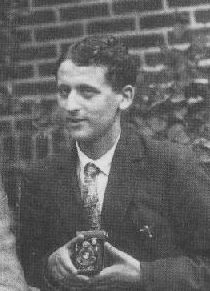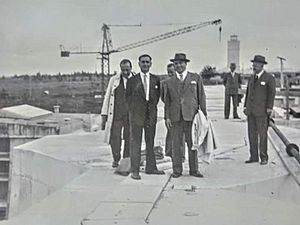Samuel Goudsmit facts for kids
Quick facts for kids
Samuel Goudsmit
|
|
|---|---|

Samuel Goudsmit around 1928
|
|
| Born |
Samuel Abraham Goudsmit
July 11, 1902 |
| Died | December 4, 1978 (aged 76) |
| Nationality | Dutch-American |
| Alma mater | University of Leiden (Ph.D) (1927) |
| Known for |
|
| Spouse(s) |
Jaantje Logher
(m. 1927; div. 1960)Irene Bejach
(m. 1960) |
| Children |
|
| Awards | National Medal of Science (1976) |
| Scientific career | |
| Fields | Physics |
| Institutions | University of Michigan |
| Doctoral students | Robert Bacher |
Samuel Abraham Goudsmit (born July 11, 1902 – died December 4, 1978) was a Dutch-American physicist. He is famous for helping to discover the idea of electron spin in 1925. He worked with another scientist named George Eugene Uhlenbeck.
Contents
Discovering Electron Spin
Samuel Goudsmit was born in The Hague, Netherlands. His family was Dutch Jewish. His father, Isaac Goudsmit, made water-closets. His mother, Marianne Goudsmit-Gompers, ran a hat shop. Sadly, during World War II in 1943, his parents were killed by the German occupiers of the Netherlands.
Goudsmit studied physics at the University of Leiden. His teacher was Paul Ehrenfest. Samuel earned his PhD degree in 1927. After finishing his studies, Goudsmit became a professor at the University of Michigan. He taught there from 1927 to 1946. In 1930, he wrote a book called The Structure of Line Spectra with Linus Pauling.
World War II and the Alsos Mission
During World War II, Samuel Goudsmit worked at the Massachusetts Institute of Technology. He led a special group called the Alsos Mission. This mission was part of the Manhattan Project. The Manhattan Project was a secret effort to build the first atomic bomb.
The Alsos Mission's goal was to find out how much progress Germany had made on its own atomic bomb project. Goudsmit and his team successfully found a group of German nuclear physicists. These scientists included Werner Heisenberg and Otto Hahn. Goudsmit's team reached them before other groups could.
In his 1947 book Alsos, Goudsmit wrote that the Germans were not close to making an atomic weapon. He believed this was because science struggled under a totalitarian government. He also thought Nazi scientists did not fully understand how to build an atomic bomb. Later historians have debated these ideas.

After the War: Science and Editing
After the war, Goudsmit was a professor at Northwestern University for a short time. From 1948 to 1970, he was a senior scientist at the Brookhaven National Laboratory. He led the Physics Department there from 1952 to 1960.
He also became well-known as the editor-in-chief of a major physics journal called Physical Review. This journal is published by the American Physical Society. In 1958, he started a new journal called Physical Review Letters. This journal published short, quick notes about new discoveries. When he retired as editor in 1974, Goudsmit moved to the University of Nevada in Reno. He stayed there until he passed away four years later.
Goudsmit also studied Egyptology, which is the study of ancient Egypt. He wrote some scholarly articles about it. His collection of Egyptian artifacts is now at the Kelsey Museum of Archaeology at the University of Michigan.
He became a member of important scientific groups. These included the Royal Netherlands Academy of Arts and Sciences in 1939 (he rejoined in 1950). He was also elected to the United States National Academy of Sciences in 1947. In 1952, he joined the American Philosophical Society. The American Academy of Arts and Sciences elected him in 1964.
Family Life
Goudsmit married his first wife, Jaantje Logher, in 1927. They divorced in 1960. In the same year, Goudsmit married Irene Bejach. Like Goudsmit's parents, Irene's father was also killed by the Nazis. He was a German doctor named Curt Dietrich Bejach. He died at the Auschwitz concentration camp.
Irene and her sister, Helga, left Germany for the United Kingdom as children. This was just before World War II began. They were part of the Kindertransport program. This program helped Jewish children escape Nazi Germany. They lived for seven years with the family of Richard Attenborough.
Samuel Goudsmit and his first wife, Jaantje, had one daughter. Her name was Esther Marianne.
See also
 In Spanish: Samuel Goudsmit para niños
In Spanish: Samuel Goudsmit para niños



